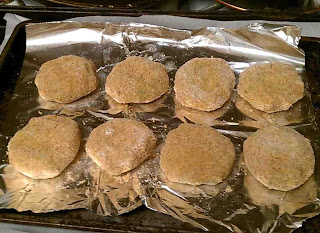To download a cookbook style copy of the recipe for
Coconut-Almond Macaroons with Apricot, click HERE.
 It seems fair to say that the macaroons with which most
people are familiar are the pasty, bland kind that are mass-produced and sold in cans. And that’s
a great shame, because really outstanding macaroons – soft, sweet and flavorful
– are one of the easiest treats you can make in your kitchen.
It seems fair to say that the macaroons with which most
people are familiar are the pasty, bland kind that are mass-produced and sold in cans. And that’s
a great shame, because really outstanding macaroons – soft, sweet and flavorful
– are one of the easiest treats you can make in your kitchen.
Not to be confused with macarons, their meringue-based
French cousins, macaroons are coconut, beaten egg whites, sugar and (usually)
chopped almonds combined with a few other simple ingredients to make a
delicious can’t-eat-just-one delight. And this week’s recipe goes even further
and adds the unusual (and highly yummy!) topping of apricot preserves. (It’s also
worth noting that one simple ingredient swap turns these macaroons from a
year-round treat to a perfect Passover cookie better – and less expensive - than
any you can buy.)
Here are the ingredients you’ll need: 3 Tbsp flour (for Passover
use Passover Cake Meal); ½ tsp salt, divided; ¾ cup sugar; zest of one orange; 3
egg whites; ¾ cup chopped or crushed almonds; 2-1/2 cups shredded coconut; and ½
cup apricot preserves.
This recipe makes about twenty-one 2” macaroons.
Add the flour mixture, a little at a time, to the beaten egg whites, mixing thoroughly after each addition.
When all of the flour mixture has been incorporated into the beaten egg whites, fold in the coconut and almonds.
Drop heaping tablespoons of the mixture onto a baking sheet lined with parchment or a silicon baking pad.
Bake for about 18 minutes or until lightly browned, turning the baking sheet half-way for even baking. When turning the baking sheet, sprinkle the remaining zest on the partially baked macaroons.
When the macaroons have cooled completely, fill each well with apricot preserves. (The macaroons will save well in an air tight container for a week.)
To download a cookbook style copy of the recipe for Coconut-Almond Macaroons with Apricot, click HERE.
The best part is that after your this batch gets eaten up - and they will - it's easy to make more!
Thanks for visiting. Be
sure to come again next week for another great recipe! Till they, stay well,
keep it about the food, and always remember to kiss the cook. ;-)















































